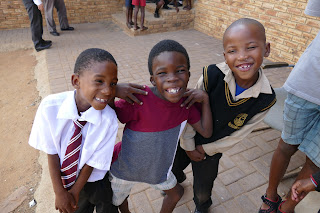This week has been a whirl.
On Monday, we met our clients face-to-face, beginning with a welcoming ceremony at the District Office. Local dignitaries attended and the Executive Mayor addressed the crowd. As people spoke, the bar was set in terms of what we’ve been asked to deliver. We were called the “best IBM could offer from around the world" . . . no pressure, right?
Members of the press also attended and a local newspaper wrote a short story on our work, you can read it here.
 |
| An example of one of the larger subsidized houses |
We spent Tuesday touring West Rand and various housing settlements (communities). These are low income, subsidized communities, where many of the residents are unemployed. Residents making less than 3,500 Rand (or $245) can apply for a housing subsidy which will cover the cost of a two-bedroom, 42 square meter house (roughly 450 square feet).
As part of these communities, you’ll also find a variety of informal settlements - resident-built “shacks” made of steel, cement block or cardboard - where resident’s rent these spaces, often located in their backyards, to other residents, as a source of income. In actuality, this is illegal in South Africa, but difficult to enforce.
It was amazing to see what people will do when they have no where to live. Some of these shacks were the size of an average American walk-in closet. Some had flowing water and electricity, others did not. Our client reminded us that we were seeing the "poorest of the poor." But, regardless of whether a person was living in a backyard shack or a subsidized house, one thing remained the same in each neighborhood we visited - the community support.
 |
| Our Braai - Delicious grilled meat! |
The communities prescribe to a principle called, "unbuntu" which means: I am, because you are. The members of the community take care of one other. If someone is short on food or supplies, another member will provide it, knowing he/she will receive the same help in return. The community is at the heart of the African culture - people working together for the common good.
We stopped for lunch as part of our tour. Our client was incredibly generous and arranged for us to have a traditional braai - basically a South African barbecue. The food was delicious. We had mounds of grilled beef and chicken, with salads and mieliepap (or pap for short - basically a thick, cornmeal, rice type texture). The restaurant owners were so proud to have a "foreign delegation" visiting them. They actually took pictures of us as we ate.
Before we headed back to the office, our client wanted to share with us something dear to his heart. In an effort to inspire and encourage us, he took us to St. John the Divine Orphans and Outreach - a local orphanage for children, many of which have lost their parents to HIV or Aids. Our client wanted us to see firsthand that good things are happening in South Africa.
When we arrived, dozens of children ran out to greet us, waving and smiling and cheering. Each one wanted their photo taken, making faces and laughing. As you can see by my blog, we happily obliged (we were also granted permission to take these photos).
We received a tour from the head of the Orphanage, Patricia - a woman they call the “big Mother.” She was so proud to walk us through the orphanage, showing us their kitchen, playrooms, and computer lab - which ended up being a room full of inoperative computer monitors from the 1990s.
 |
| Dozens of elementary-aged children greeted us with smiles! |
Of course, our team was incredibly moved by what we saw and by the wonderful work happening at the Orphanage. You couldn’t help but want to do something to improve their circumstances.
We scrounged together a few hundred Rand, the equivalent of about $35. When we gave Patricia our meager offering, she was so incredibly thankful. She told us the money we provided would allow the children to eat beans and meat later in the week. She said she would be using the money to purchase chicken at the local market.
When we left the Orphanage, I could’t help but want to do more. Not only do they need computers - which they plan to use to raise money as an internet cafe and to educate the students - but they also need basic items like clothing and shoes for the children, or vegetables and alternative forms of nutrition. In the US, we often hear about orphanages and children overseas in need of assistance, but to see it firsthand, really tears at your heart. I hope to help in any small way I can - even if that means making another donation, or maybe purchasing a few supplies to donate before we leave. At the very least, I look forward to staying in touch and hearing more about the good work Patricia, her husband, and the community are doing for these beautiful children.
I've spent a total of six days in Africa so far - and every night, I go to bed reminding myself how lucky I truly am.
 |
| Our team at lunch |
 |
| All smiles! |
 |
| Children working on their homework |
 |
| Computer Lab at the Orphanage |
 |
| Patricia, or "Big Mother" - She leads the Orphanage |
 |
| An example of a well-done subsidized community |
 |
| Another example of a some housing we saw - this was mining housing |

No comments:
Post a Comment